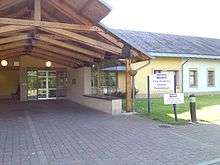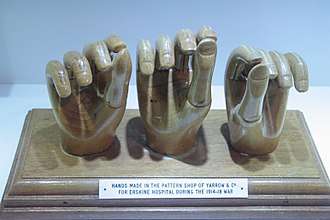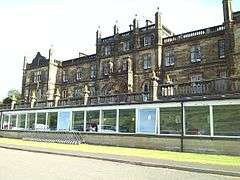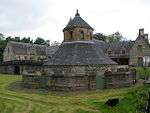Erskine (charity)
Erskine is a Veterans care charity in Erskine, Renfrewshire, Scotland. It provides long-term nursing, respite, dementia and end-of-life medical care for veterans of the British Armed Forces who have settled in Scotland. The charity also provides a range of individual and family accommodation and Veterans Activity Centres. The charity opened and established itself as Princess Louise Scottish Hospital for Limbless Sailors and Soldiers in 1916. Its name was then shortened to Erskine Hospital and then simply "Erskine" in later years. It was opened due to the need to treat the thousands of military personnel who lost their limbs in the First World War. The charity has gone on to offer help to British veterans of the First World War and every subsequent war.[1] It has gone on to become the biggest ex-services facility in the country.[2]
| Erskine | |
|---|---|
 Erskine Home | |
%26groups%3D_b10fb6ba382ed9164dd49495e0e486caca41ebdd.svg)
| |
| Geography | |
| Location | Erskine, Scotland |
| Coordinates | 55°55′02″N 4°28′40″W |
| Organisation | |
| Care system | Private |
| Funding | Charity |
| Type | Veterans hospital |
| Patron | Prince Charles |
| History | |
| Opened | 1916 |
| Links | |
| Website | erskine |
History

A need for a dedicated war hospital was apparent during the First World War, as hospitals were struggling to keep up with the demands of the many limbless soldiers and sailors returning from war. It was then thought that Scotland should have a large, modern war hospital to cope with these type of injuries. A charitable committee was formed after a meeting in Glasgow. Sir William Macewen, a chief surgeon, was at the forefront of pushing through the need for such a facility. He met with Sir Thomas Dunlop the Lord Provost of Glasgow, who was enthusiastic.
The next stage was to find a location for the hospital in the west of Scotland. After reviewing several sites it was decided that Erskine would be the location. Thomas Aikman, the owner of Erskine House, which is a mansion on the banks of the River Clyde, offered free use of his mansion and gardens for the period of the war and for 12 years after it was declared over. Then Sir John Reid, a charity committee member, bought the mansion house and gardens and gifted them to the charity. Princess Louise, Duchess of Argyll agreed to become the patron of the hospital and within a few weeks the Scottish public had donated £100,000 towards the facility.
The hospital was opened on 10 October 1916 and had an official opening on 6 June 1917 with Princess Louise making an appearance.[3][4]
Expansion
Erskine's role has since expanded to meet the changing needs of war veterans. It now cares for any ex-service people and their spouses, who might be facing the challenges of long-term or degenerative health conditions. It also provides convalescent care for those recovering from illness - and provides hotel and support services for the Army's Personnel recovery Centre, at its Gilmerton Home in Edinburgh . [3]
By 1980, there were new departments available for ex-service people. These included a social work and speech therapy department. Erskine House, which was the original hospital building, needed extensive work to continue as a working hospital. The building was sold as part of the vision to modernize Erskine. It was then turned into a 5-star hotel called the Earl of Mar, later known as Mar Hall. It opened in 2004.[3][5]
The current CEO is Wing Commander Ian Cumming MBE. The CEO overseas Erskine as it enters a phase of expanding its services and insights - as a centre of excellence in Veterans Care & Support - more widely.
Erskine Home
In 2000-01, the charity moved to two new purpose built sites in the town of Erskine. The Erskine Home was opened in 2000. The new flagship building replaced the original hospital building and is situated on grounds by the Erskine Bridge. This centre cost £16m and provides nursing and dementia care on a long term and respite basis. It has 180 beds available and is the biggest unit the charity has. Prince Charles, the charity's patron, opened the unit and unveiled a stone plaque to commemorate the opening.[2][3][6]
Erskine Park Home
The Erskine Park Home opened in 2006. It offers care for 40 residents and specializes in dementia care. It is situated again within rural parkland by the Erskine Bridge. The Princess Royal has maintained her strong links with the charity and once again opened this Erskine based unit.[3][6]
Erskine Edinburgh Home
The Erskine Edinburgh Home was opened in 2001. It is situated in Gilmerton and has capacity for 88 residents and additionally provides hotel accommodation and support to younger Service people passing through the Personnel Recovery Centre . This was the charity's first unit outside the Erskine area. This was also opened by the Princess Royal.[3][6]
Erskine Glasgow Home
The Erskine Glasgow Home was opened by the Princess Royal in 2007. It is situated in Anniesland and has space for 46 residents. It also has partnership arrangements with care homes in Aberdeen, Dundee and Inverness.[3][6]
Veterans' Accommodation
Erskine has also rebuilt 50 veterans' cottages within the old hospital grounds at Erskine to house ex-service members and their families. It recently completed building 5 assisted living apartments for elderly veterans who seek to remain independent but close to expert staff. Erskine is also building a 24 apartment complex for younger Veterans without a home[1][3]
Reid Macewen Centre
This unit was first opened as a training and conference facility. It now offers "psychosocial support", recreational and community activities for Veteran on the West Coast who are struggling with social isolation and loneliness. It is housed within the historic stable building at the charity's HQ within the Bishopton Estate. It is jointly named after Sir John Reid, who gifted the mansion and gardens to the charity, and Sir William Macewen, the surgeon who pushed through the need for the hospital. As the building is Category B listed, the charity collaborated with Historic Scotland and the Heritage Lottery Fund on the renovation. It was officially opened in June 2001 by Wendy Alexander MSP.[7] Erskine intends to replicate centres like these in Central Scotland, Inverness, Aberdeenshire, Fife & Tayside.
Funding
Erskine is first and foremost a charity. Local Authorities make a contribution to its operating costs of caring for their elderly citizens. However, Erskine must fundraise around £12M a year, to achieve the outstanding levels of care, support and meaningful community activities, which the charity believes Veterans deserve. Fundraising schemes are active throughout the year and in 2017, Erskine was rated as Scotland's most effective fundraising charity by Civil Society Magazine. The charity hosts many events including an annual motorbike meet and classic car show. Veterans also partake in various woodwork and craft activities with daily activities taking place in the Bunker. [8] [9] The charity will accept the help of volunteers from the public.[10]
Artificial limbs
There was a huge influx of injured military personnel returning from the First World War with missing limbs due to the fighting. Britain at this time was wholly dependent on foreign imports of artificial limbs. Sir William Macewan, the chief surgeon at the hospital, thought that this was intolerable. A dispensary and operating theatre were fitted out as workshops making artificial limbs. Mcewan also enlisted the help of a local shipbuilding company called Yarrow Shipbuilders. The company not only lent their yard but chose to have some of their best craftsmen working on the design and construction of the limbs. McEwan and Yarrows subsequently designed a new concept artificial limb known as the Erskine Artificial Limb. By December 1917 the hospital had treated 1,613 patients and of that number 1,126 required a new limb. And by 1920, there had been 9,500 artificial limbs fitted. Most of these were manufactured at the hospital’s workshops.[3][4]
Listed buildings
The original hospital building is called Erskine House and is a Category A listed building. It is now the Mar Hall Hotel. There is a piggery, a stables yard and some other small buildings which also have listed status.[11]
Gallery
 Erskine House which was the site of the original hospital. It is now the Mar Hall Hotel.
Erskine House which was the site of the original hospital. It is now the Mar Hall Hotel. The Category B listed Piggery building and Stables yard.
The Category B listed Piggery building and Stables yard. Reid McEwen Veterans Activity Centre, which is also a Category B listed building.
Reid McEwen Veterans Activity Centre, which is also a Category B listed building. Erskine Home Bishopton - The charity's Head Office
Erskine Home Bishopton - The charity's Head Office
References
- "Domesday Reloaded: Erskine Hospital". BBC. Retrieved 25 June 2014.
- "Erskine Hospital receives 16m royal relaunch Prince opens country's biggest ex-services facility". Herald Scotland. 12 October 2000. Retrieved 26 June 2014.
- "The history of Erskine". Rememberingscotlandatwar.org.uk. Archived from the original on 4 March 2016. Retrieved 25 June 2014.
- "History of Erskine House: Former World War 1 hospital, now 5-star Mar Hall Hotel - Clyde Waterfront Heritage". Clydewaterfront.com. Retrieved 25 June 2014.
- "Erskine - Renfrewshire Council". Renfrewshire.gov.uk. Archived from the original on 23 May 2014. Retrieved 26 June 2014.
- "Care homes". Erskine. Retrieved 25 June 2014.
- "Wendy Alexander opens Erskine hospital's new training and conference facility". Scotland.gov.uk. 20 June 2001. Retrieved 26 June 2014.
- "Social & Fundraising Events". Erskine. 24 October 2013. Archived from the original on 27 July 2014. Retrieved 26 June 2014.
- "Go purple for Erskine Week". Erskine. Archived from the original on 2 July 2014. Retrieved 26 June 2014.
- "Volunteering". Erskine. Retrieved 26 June 2014.
- "Site Record for Erskine House, Erskine Hospital & War Memorial". Canmore.rcahms.gov.uk. Retrieved 26 June 2014.